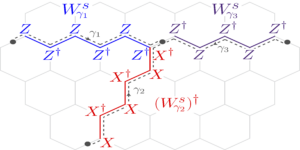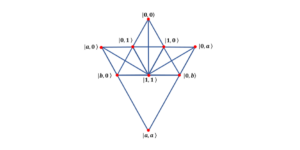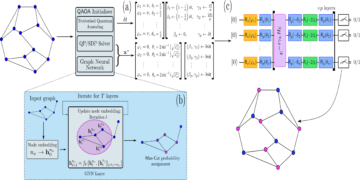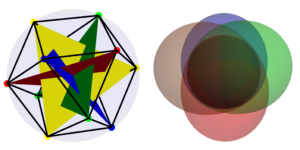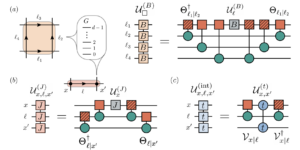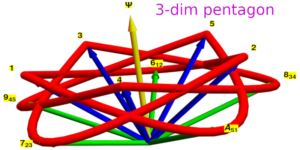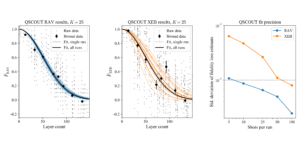1Física Teòrica: Informació i Fenòmens Quàntics, Departament de Física, Universitat Autònoma de Barcelona, 08193 Bellaterra, Spain
2ICREA, Pg. Lluís Companys 23, 08010 Barcelona, Spain
Find this paper interesting or want to discuss? Scite or leave a comment on SciRate.
Abstract
We investigate attractor quantum neural networks (aQNNs) within the framework of coherence theory. We show that: i) aQNNs are associated to non-coherence-generating quantum channels; ii) the depth of the network is given by the decohering power of the corresponding quantum map; and iii) the attractor associated to an arbitrary input state is the one minimizing their relative entropy. Further, we examine faulty aQNNs described by noisy quantum channels, derive their physical implementation and analyze under which conditions their performance can be enhanced by using entanglement or coherence as external resources.

Popular summary
When dealing with their quantum analogue, dubbed as attractor quantum neural network (aQNN), the dynamical process leading to the state of minimal energy is described by a quantum channel, $Lambda$, whose maximum number of stationary states corresponds to the storage capacity of the aQNN. Interestingly, such quantum channels correspond to a set of well known operations in the context of the resource theory of coherence. Such observation motivates our choice to address aQNNs from a coherence-theoretic approach.
Within this framework, we characterize the properties of aQNNs, such as their physical implementation and the depth of the network, i.e, the number of times the map $Lambda$ has to be applied to retrieve faithfully the state which is closest to the initial input, as schematically depicted in the plot.
In this case we prove that genuinely incoherent operations (GIOs) describe the evolution of aQNNs with maximal storage capacity. Moreover, we show that neither coherence nor entanglement can be exploited as resources to enhance their performance.
Finally, we address the above issues also in the context of faulty aQNNs, that is when some error in the realization of the network is taken into account. In this case, we demonstrate that the corresponding aQNNs are described either by strictly incoherent operations (SIOs) or by maximally incoherent operations (MIOs), thus opening the possibility, in the latter case, to an enhancement of their performance by using coherence as an external resource.
► BibTeX data
► References
[1] Diego Ristè, Marcus P Da Silva, Colm A Ryan, Andrew W Cross, Antonio D Córcoles, John A Smolin, Jay M Gambetta, Jerry M Chow, and Blake R Johnson. Demonstration of quantum advantage in machine learning. npj Quantum Information, 3 (1): 1–5, 2017. 10.1038/s41534-017-0017-3.
https://doi.org/10.1038/s41534-017-0017-3
[2] Giuseppe Carleo, Ignacio Cirac, Kyle Cranmer, Laurent Daudet, Maria Schuld, Naftali Tishby, Leslie Vogt-Maranto, and Lenka Zdeborová. Machine learning and the physical sciences. Rev. Mod. Phys., 91: 045002, Dec 2019. 10.1103/RevModPhys.91.045002.
https://doi.org/10.1103/RevModPhys.91.045002
[3] Yunchao Liu, Srinivasan Arunachalam, and Kristan Temme. A rigorous and robust quantum speed-up in supervised machine learning. Nature Physics, 17 (9): 1013–1017, 2021. 10.1038/s41567-021-01287-z.
https://doi.org/10.1038/s41567-021-01287-z
[4] Maria Schuld, Ilya Sinayskiy, and Francesco Petruccione. The quest for a quantum neural network. Quantum Information Processing, 13 (11): 2567–2586, Nov 2014. ISSN 1573-1332. 10.1007/s11128-014-0809-8.
https://doi.org/10.1007/s11128-014-0809-8
[5] Daniel J Amit. Modeling brain function: The world of attractor neural networks. Cambridge university press, 1989. https://doi.org/10.1017/CBO9780511623257.
https://doi.org/10.1017/CBO9780511623257
[6] J J Hopfield. Neural networks and physical systems with emergent collective computational abilities. Proceedings of the National Academy of Sciences, 79 (8): 2554–2558, 1982. ISSN 0027-8424. 10.1073/pnas.79.8.2554.
https://doi.org/10.1073/pnas.79.8.2554
[7] D. Ventura and T. Martinez. Quantum associative memory with exponential capacity. In 1998 IEEE International Joint Conference on Neural Networks Proceedings. IEEE World Congress on Computational Intelligence (Cat. No.98CH36227), volume 1, pages 509–513 vol.1, 1998. 10.1109/IJCNN.1998.682319.
https://doi.org/10.1109/IJCNN.1998.682319
[8] Patrick Rebentrost, Thomas R. Bromley, Christian Weedbrook, and Seth Lloyd. Quantum hopfield neural network. Phys. Rev. A, 98: 042308, 2018. 10.1103/PhysRevA.98.042308.
https://doi.org/10.1103/PhysRevA.98.042308
[9] Nicholas Meinhardt, Niels MP Neumann, and Frank Phillipson. Quantum hopfield neural networks: A new approach and its storage capacity. In International Conference on Computational Science, pages 576–590. Springer, 2020. 10.1007/978-3-030-50433-5_44.
https://doi.org/10.1007/978-3-030-50433-5_44
[10] Yudong Cao, Gian Giacomo Guerreschi, and Alán Aspuru-Guzik. Quantum neuron: an elementary building block for machine learning on quantum computers. arXiv preprint arXiv:1711.11240, 2017. 10.48550/arXiv.1711.11240.
https://doi.org/10.48550/arXiv.1711.11240
arXiv:1711.11240
[11] Maciej Lewenstein, Aikaterini Gratsea, Andreu Riera-Campeny, Albert Aloy, Valentin Kasper, and Anna Sanpera. Storage capacity and learning capability of quantum neural networks. Quantum Science and Technology, 6 (4): 045002, jul 2021. 10.1088/2058-9565/ac070f.
https://doi.org/10.1088/2058-9565/ac070f
[12] Maciej Lewenstein, Aikaterini Gratsea, Andreu Riera-Campeny, Albert Aloy, Valentin Kasper, and Anna Sanpera. Corrigendum: Storage capacity and learning capability of quantum neural networks (2021 quantum sci. technol. 6 045002). Quantum Science and Technology, 7 (2): 029502, mar 2022. 10.1088/2058-9565/ac419f.
https://doi.org/10.1088/2058-9565/ac419f
[13] Zi-Wen Liu, Xueyuan Hu, and Seth Lloyd. Resource destroying maps. Phys. Rev. Lett., 118: 060502, Feb 2017. 10.1103/PhysRevLett.118.060502.
https://doi.org/10.1103/PhysRevLett.118.060502
[14] Eric Chitambar and Gilad Gour. Critical examination of incoherent operations and a physically consistent resource theory of quantum coherence. Phys. Rev. Lett., 117: 030401, Jul 2016. 10.1103/PhysRevLett.117.030401.
https://doi.org/10.1103/PhysRevLett.117.030401
[15] Johan Aberg. Quantifying superposition. arXiv preprint quant-ph/0612146, 2006. https://doi.org/10.48550/arXiv.quant-ph/0612146.
https://doi.org/10.48550/arXiv.quant-ph/0612146
arXiv:quant-ph/0612146
[16] T. Baumgratz, M. Cramer, and M. B. Plenio. Quantifying coherence. Phys. Rev. Lett., 113: 140401, Sep 2014. 10.1103/PhysRevLett.113.140401.
https://doi.org/10.1103/PhysRevLett.113.140401
[17] Andreas Winter and Dong Yang. Operational resource theory of coherence. Phys. Rev. Lett., 116: 120404, Mar 2016. 10.1103/PhysRevLett.116.120404.
https://doi.org/10.1103/PhysRevLett.116.120404
[18] Julio I. De Vicente and Alexander Streltsov. Genuine quantum coherence. Journal of Physics A: Mathematical and Theoretical, 50 (4), jan 2017. ISSN 17518121. 10.1088/1751-8121/50/4/045301.
https://doi.org/10.1088/1751-8121/50/4/045301
[19] Carmine Napoli, Thomas R. Bromley, Marco Cianciaruso, Marco Piani, Nathaniel Johnston, and Gerardo Adesso. Robustness of coherence: An operational and observable measure of quantum coherence. Phys. Rev. Lett., 116: 150502, Apr 2016. 10.1103/PhysRevLett.116.150502.
https://doi.org/10.1103/PhysRevLett.116.150502
[20] Kaifeng Bu and Chunhe Xiong. A note on cohering power and de-cohering power. arXiv preprint arXiv:1604.06524, 2016. https://doi.org/10.48550/arXiv.1604.06524.
https://doi.org/10.48550/arXiv.1604.06524
arXiv:1604.06524
[21] Yi Peng, Yong Jiang, and Heng Fan. Maximally coherent states and coherence-preserving operations. Phys. Rev. A, 93: 032326, Mar 2016. 10.1103/PhysRevA.93.032326.
https://doi.org/10.1103/PhysRevA.93.032326
[22] Vern Paulsen. Completely Bounded Maps and Operator Algebras. Cambridge Studies in Advanced Mathematics. Cambridge University Press, 2003. 10.1017/CBO9780511546631.
https://doi.org/10.1017/CBO9780511546631
[23] Yao Yao, G. H. Dong, Xing Xiao, Mo Li, and C. P. Sun. Interpreting quantum coherence through a quantum measurement process. Phys. Rev. A, 96: 052322, Nov 2017. 10.1103/PhysRevA.96.052322.
https://doi.org/10.1103/PhysRevA.96.052322
[24] Azam Mani and Vahid Karimipour. Cohering and decohering power of quantum channels. Phys. Rev. A, 92: 032331, Sep 2015. 10.1103/PhysRevA.92.032331.
https://doi.org/10.1103/PhysRevA.92.032331
[25] Khaled Ben Dana, María García Díaz, Mohamed Mejatty, and Andreas Winter. Erratum: Resource theory of coherence: Beyond states [phys. rev. a 95, 062327 (2017)]. Phys. Rev. A, 96: 059903, Nov 2017. 10.1103/PhysRevA.96.059903.
https://doi.org/10.1103/PhysRevA.96.059903
[26] María García Díaz, Kun Fang, Xin Wang, Matteo Rosati, Michalis Skotiniotis, John Calsamiglia, and Andreas Winter. Using and reusing coherence to realize quantum processes. Quantum, 2: 100, October 2018. ISSN 2521-327X. 10.22331/q-2018-10-19-100.
https://doi.org/10.22331/q-2018-10-19-100
[27] Masaya Takahashi, Swapan Rana, and Alexander Streltsov. Creating and destroying coherence with quantum channels. Phys. Rev. A, 105: L060401, Jun 2022. 10.1103/PhysRevA.105.L060401.
https://doi.org/10.1103/PhysRevA.105.L060401
[28] John Watrous. Semidefinite programs for completely bounded norms. Theory of Computing, 5 (11): 217–238, 2009. 10.4086/toc.2009.v005a011.
https://doi.org/10.4086/toc.2009.v005a011
[29] Dorit Aharonov, Alexei Kitaev, and Noam Nisan. Quantum circuits with mixed states. In Proceedings of the thirtieth annual ACM symposium on Theory of computing, pages 20–30, 1998. 10.1145/276698.276708.
https://doi.org/10.1145/276698.276708
[30] Mark M Wilde. From classical to quantum shannon theory. arXiv preprint arXiv:1106.1445, 2011. 10.1017/9781316809976.001.
https://doi.org/10.1017/9781316809976.001
arXiv:1106.1445
Cited by
This Paper is published in Quantum under the Creative Commons Attribution 4.0 International (CC BY 4.0) license. Copyright remains with the original copyright holders such as the authors or their institutions.

